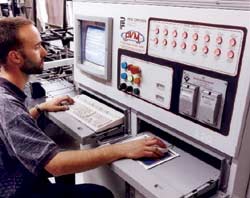 Laser
Scanner Used to Help Design Programmable Vehicle Models Laser
Scanner Used to Help Design Programmable Vehicle Models
NVision’s ModelMaker W70
Prefix Corp., an engineering company located in Rochester
Hills, Michigan, develops fully configurable vehicle interior
design and prototype bucks called programmable vehicle models.
These PVMs are used to help automotive OEMs shorten vehicle
research and development cycles, reduce production leadtime
and cut prototype development costs. For example, customers
can sit in a vehicle and adjust all the interior components,
such as instrument panel, steering column, pedal package
and others, until they’re comfortable. In the past,
Prefix used a digitizer arm to collect measurements that
were needed to match the PVM to competitive vehicles used
as a benchmark for consumer studies. This process proved
to be time-consuming because the device captures points
one at a time and the operator must manually move the steering
system to track each point to be measured.
The time involved made it impractical to completely reverse
engineer anything outside the components and assemblies.
The company needed a more advanced measurement capability
that would make it possible to collect more data points
in less time, notes Kurt Zeile, engineering manager for
Prefix. Collecting accurate measurements from vehicles that
are used to configure the PVM is a critical aspect. Zeile
looked at a number of different alternatives and selected
the ModelMaker W70 from NVision.
The ModelMaker system consists of a 3-D laser sensor,
an articulated mechanical digitizer or portable CMM to which
the sensor is attached, a PC and software that extracts,
displays and manipulates the data. By switching to a laser
scanner, the company is able to collect far more data in
less time than was possible in the past. “I looked
at white-light scanners but came to the conclusion that
they weren’t as flexible as I would like because they
capture multiple discrete images that need to be manually
stitched together,” Zeile explains. “The ModelMaker
avoids this because it captures a single continuous model.
Another factor in our decision was that it was apparent
from the start that NVision would be very responsive to
our needs.”
The ModelMaker’s sensor is a single-viewpoint laser-stripe
sensor that projects a line of laser light onto the object
while a small CCD camera views the line as it appears on
the surface. The portable sensor moves freely about the
body, allowing the technician to position the sensor easily
and capture data rapidly and with a high degree of resolution.
As the technician moves the sensor over the surface of the
part, a dedicated PCI interface card translates the video
image of the line into 3-D coordinates. This data is combined
with the Cartesian and angular coordinates generated at
each position of the mechanical arm. The result is a dense
cloud of 3-D data describing the surface of the part.
These point clouds are then turned into nurbs surfaces
that require little or no touch-up in their CAD systems.
Prefix then uses the resulting surface models to program
the PVM. “The ModelMaker W70 dramatically improves
the effectiveness of the PVM by allowing us to capture more
of the data that we need to configure the device in less
time,” Zeile concludes.
NVision’s ModelMaker W70
- High-speed data collection at 25 stripes per second
over a stripe width of up to 140 mm
- Creates coordinate frames using the hard probe on the
arm or laser scan data
- Laser stand-off indication
- Multisite scanning for complete car bodies
www.nvision3d.com
|